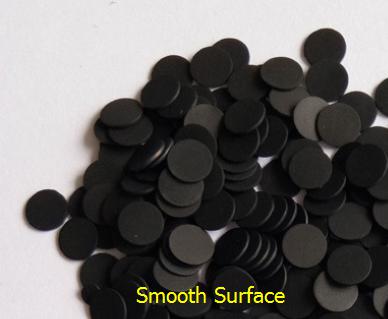Hot Keywords:
- All
- Product Name
- Product Keyword
- Product Model
- Product Summary
- Product Description
- Multi Field Search

Carbon Pills
Better-Silicone
3903900000
| Availability: | |
|---|---|
| Quantity: | |
Carbon Pills also are called carbon pad, conductive graphites, conductive carbon contact, and graphites pills for rubber keypad. Conductive carbon pills are commonly used in silicone rubber keypad as conduction part. There are four conductive ways for rubber keypad buttons, condutive carbon pills, condutive ink printing, metal pills and metal domes. In condutcive rubber keypad, when press the rubber buttons, button webbing will cause actuation force. Then rubber button conductive carbon pills will contact PCB and electricity occurs.
Carbon Pills & Graphites are made from silicone rubber with carbon. Condutcive carbon pad can be die cut into different shape. The most common shape is round. Oval or rectangle is also available. Conductive graphites can be made into different resistance. The lowest resistance of carbon pills can be less than 10 Ohms. Common resistance is 10-100 Ohms.
Carbon Pills Types
Smooth matte carbon pills: surface is matte and smooth.
Textured carbon pills: there are small grids on the surface
Low resistance condutive graphite pills: less than 10 Ohms
Common resistance carbon contact: less than 50 Ohms

Carbon Pills off the shelf in Better Silicone
Different diameter carbon pills are for sale in Better Silicone. For other sizes, carbon pills die cutting tool need to be customized.
How to Stick Carbin Pills to Rubber Keypad
Carbon pills are molded into rubber keypad bottom during compression molding. A carbon pill positioning tool is made according to rubber keypad mould size and mould cavities. Carbon pill positioning tool is used to grip conductive pills to rubber keypad mould cavities. During vulcanization, carbon pills will stick to the keypad bottom.
Carbon Pills also are called carbon pad, conductive graphites, conductive carbon contact, and graphites pills for rubber keypad. Conductive carbon pills are commonly used in silicone rubber keypad as conduction part. There are four conductive ways for rubber keypad buttons, condutive carbon pills, condutive ink printing, metal pills and metal domes. In condutcive rubber keypad, when press the rubber buttons, button webbing will cause actuation force. Then rubber button conductive carbon pills will contact PCB and electricity occurs.
Carbon Pills & Graphites are made from silicone rubber with carbon. Condutcive carbon pad can be die cut into different shape. The most common shape is round. Oval or rectangle is also available. Conductive graphites can be made into different resistance. The lowest resistance of carbon pills can be less than 10 Ohms. Common resistance is 10-100 Ohms.
Carbon Pills Types
Smooth matte carbon pills: surface is matte and smooth.
Textured carbon pills: there are small grids on the surface
Low resistance condutive graphite pills: less than 10 Ohms
Common resistance carbon contact: less than 50 Ohms

Carbon Pills off the shelf in Better Silicone
Different diameter carbon pills are for sale in Better Silicone. For other sizes, carbon pills die cutting tool need to be customized.
How to Stick Carbin Pills to Rubber Keypad
Carbon pills are molded into rubber keypad bottom during compression molding. A carbon pill positioning tool is made according to rubber keypad mould size and mould cavities. Carbon pill positioning tool is used to grip conductive pills to rubber keypad mould cavities. During vulcanization, carbon pills will stick to the keypad bottom.
Silicone Rubber Keypad | Self Adhesive Gaskets | Rubber Sealing Gasket | Rubber Bellows | Rubber Button | Silicone Keyboard Cover | Membrane Keyboard | Membrane Switches | Remote Control Keyboard | POS Keyboard | Keypad Legends | Conductive Keypad | Keypad Cover | Keypad Feature | Liquid Silicone Rubber | Screen Printing Keyboard | Laser Keyboard | Conductive Metal Pills | Metal Dome | Conductive Button | Carbon Pills | Conductive Printing | Epoxy Coating | PU Coating | Matte Smooth | Color Coating | Plastic Key Cover | Metal Key Cover | Fluorescent keyboard | Molded Keypad | Backlight Keypad | Translucent Keyboard